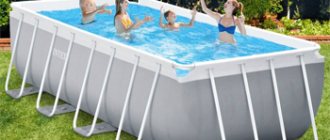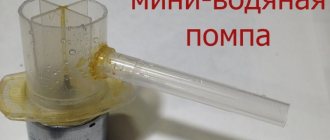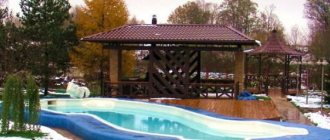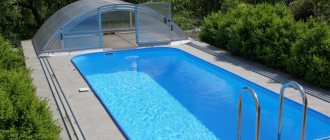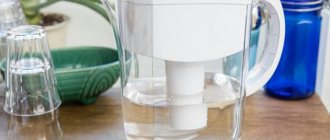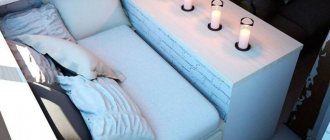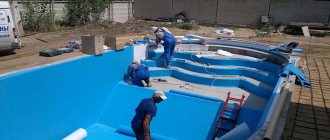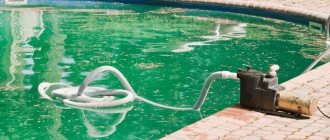A concrete pool is becoming the most popular for country houses. And this is no coincidence; it has a number of advantages over other types:
- Stationary;
- Perennial;
- Budget;
- Involves many design solutions;
- Variety of colors;
- Eco-friendly;
- Durable.
And, of course, it is important for everyone how the pool will look after construction is completed, what finishing materials to use so that the view is beautiful and the costs are low. There are many options for finishing the pool:
- Tile;
- Polypropylene film;
- Mosaic;
- Dye.
The most economical type is to paint the inner bowl of the pool. Today, the building materials market offers a huge range of pool paints. Rubber pool paint has waterproofing properties. What paint is best to paint a swimming pool? Find out here.
The cost of rubber paint varies depending on the manufacturer, the approximate price is from 195 to 400 rubles. per kg.
Rubber pool paint: pros and cons
Advantages of acrylic material
Rubber paint for swimming pools has a number of advantages that are not available to most paints and varnishes, namely:
- Increased waterproofing layer;
- Elasticity;
- Resistance to temperature changes;
- Resistance to mechanical deformation;
- High degree of adhesion;
- No peeling;
- Easy to apply using a spray gun or by hand;
- Profitable price;
- Versatility of use;
- Waterproof;
- No smell;
- Fire and explosion safety;
- Durability.
Rubber paint is characterized by increased resistance to the negative effects of the external environment, including sea water.
The presented type of paint and varnish products, when applied in two or more layers, has a striking difference from all previously invented products. In terms of tactile sensations, rubber paint literally resembles rubber, pleasant and soft. It can be used to cover any surface, as a result of which it will become matte-smooth, while removing the smallest nicks and cracks.
Rubber paint represents an innovation in water-based acrylic paints. According to environmental studies, the ingredients included in its composition do not pose any harm to the environment and human health throughout the entire period of operation, since no harmful substances are released.
Disadvantages of waterproofing
The only disadvantages include the prohibition of using it for painting furniture, floors or doors. You also need to be extremely careful with solvents that negatively affect rubber paint.
Possessing a wide range of color shades, rubber paint allows novice craftsmen and professional designers to play to their hearts’ content with the most original and daring solutions. The most commonly used color is blue for pool water.
Video
From this video you will learn how to paint a swimming pool with rubber paint to waterproof the soil.
The absence of harmful substances for the environment will allow you to spend a long time in your favorite pool without fear and not be afraid for the health of your loved ones. Even if you are not an experienced builder or painter, believe me, application will not be difficult, and timely care will save you from cracks, chips and other troubles. The wide selection presented in construction supermarkets will allow you to choose the product that suits you at a reasonable cost. Use rubber paint and make sure it's simple, economical, and most importantly durable!
Maybe
Waterproof pool paint - long-lasting protection
There used to be a belief that paint would not withstand constant exposure to water, but modern chemists have refuted this by creating a wonderful paint for swimming pools. This coating is particularly resistant to impact and abrasion, and it is absolutely impermeable to water.
When it comes to finishing the pool, many are inclined to paint it, because this type of finishing will cost much less than tiles or mosaics and will last a fairly long period.
Why do most builders choose concrete paint for their pool?
The most popular type of pool has become a reinforced concrete pool. Firstly, because concrete is a fairly strong and durable material, and secondly, a reinforced concrete pool can be of any shape and depth. A special paint for concrete pools was developed, which has already shown itself only on the good side.
One of the most used types of paint is acrylic pool paint. This paint is characterized by high water resistance, elasticity and mechanical strength. It is used for decorative and protective painting of the underwater and above-water parts of the pool. The waterproof paint proved to be excellent in use. Acrylic paint for swimming pools, reviews of which are only positive, of course, if you buy high-quality paint from a specialized color studio.
Also quite often, rubber pool paint is used to paint swimming tanks. Rubber paint is used for swimming pools because it covers the concrete walls of the pool with a breathable, waterproof film. Rubber paint for a concrete pool shows excellent performance. You can apply this paint directly onto concrete, and if necessary, you can use it to cover tiles that have lost their appearance.
What properties should pool paint have?
Of course, first of all, when thinking about how to paint a pool, you must understand what to expect from good paint. Pool paint should be a good sealant and waterproof. It should be resistant to both frost and heat, and the scorching rays of the sun should not change its color.
Since people swim in the pool, the paint should not cause allergies. As a rule, to prevent water from becoming contaminated, various chemicals are added to the water, which are not harmful to humans, but are deadly to bacteria; therefore, the paint should not be destroyed under the influence of bleach and alkaline solutions. Also, the paint itself should protect the surface of the pool from fungus and mold. Only two-component epoxy paints for concrete and metal pools meet such high requirements.
Where can I buy this material and what does its cost depend on?
We strongly recommend purchasing pool paint from specialty stores or color studios. Our color studios observe special conditions for storing paint and varnish products, under which all paints retain their properties.
Concrete pool painting technology
- Purchase chlorinated rubber paint from a hardware store.
- Remove water, various debris and pollution from the reservoir.
- Clean the concrete surface with a wire brush and scraper to remove old paint, remove all dust, wash the entire surface of the pool with a 50% acid solution, and rinse with clean water.
- To neutralize the acidic composition, treat the pool with 3-sodium phosphate solution, degrease the surface, and rinse again with clean water.
- Fill all defects (cracks, holes) with cement mortar.
- Be sure to let the entire surface dry.
- Apply elastomer-based paint with a wide roller, starting from the deepest place, moving up to the top, using a brush to paint hard-to-reach places (valves, lamps, drainage).
- Paint with rubber must dry for the period of time specified in the manufacturer's instructions, as this is necessary for reliable and durable fixation (approximately 3-5 days).
- Fill your new pool with water and change the filtration settings for service.
Additional recommendations:
- Be sure to thoroughly mix the coloring composition before use;
- do not carry out work when it is very hot, cold or high humidity (the surface may stick together);
- apply the composition in the thinnest layer so that bubbles do not appear;
- When working with acidic cleaning mixtures, be sure to wear safety glasses and gloves.
Pool paint containing elastomers is the optimal and ideal choice. You no longer need to redo your pond every few years, because this material is durable and reliable. And there is no need to worry about your pool leaking water.
Latex paint application process
- When laying chlorinated rubber paint, the metal surface must be cleaned of rust and grease, the concrete base must be treated with a primer, if the surface was previously painted with alkyd or oil paint, washed with soda or sodium phosphate.
- Carry out a test painting with the rubber compound to determine the thickness, color and drying time.
- The rubber composition is applied to the base in several thin layers, at intervals of a couple of hours, to increase wear resistance.
Chlorine rubber paint for pools is considered the most common for painting the surfaces of swimming pools and artificial reservoirs; it is available in a wide range of colors and is also low cost.
However, if you decide to paint your pool with elastomer-based paint, you need to carefully select the coloring rubber composition, bring the pond into proper shape, and carefully study the instructions for use.
Chlorine rubber paint is very popular in terms of price-quality ratio.
If you choose the right materials, spend a little time and put in a little effort, you will get a completely transformed pool without spending a lot of money. To do this, you will need the following materials and tools - paint with rubber, paint containers, a large roller (wide), brushes, protective gloves and glasses, cleaner, scrapers, wire brush, 3 sodium phosphate.
Painting a concrete pool with liquid blue paint
It is advisable to carry out preparatory work in stages:
- Sand;
- Putty, then sand;
- Treat with primer;
- Degrease the surface;
- Sand all glossy surfaces, if any, to a matte finish;
- Rinse the area with water and dry.
If desired, in order to improve the protective properties and reduce paint consumption, after thorough processing, auxiliary layers of putty, primers, and antiseptic compounds can be applied.
Before directly applying liquid rubber, it is important to adhere to the following rules:
Mix the paint thoroughly before use; If necessary, dilute the paint with water, although this is often not required; Apply to a dry surface with a brush or roller in a couple of layers.
If you work with a sprayer, make sure that the temperature does not drop below five degrees. When working, stir the paint product regularly; Apply the next layer exclusively to the dried surface of the previous one; At the end of the work, do not forget to rinse the tools thoroughly. This material will tell you what a rubber coating for playgrounds in the country is.
This material will tell you what rubber coating is for children's playgrounds in the country.
After painting, try to maintain the coating regularly. It is not particularly difficult, but will allow the rubber paint to serve you for a long time. To do this, it is enough to periodically monitor the surface and, if necessary, carry out restoration of the pool:
- Remove rust;
- Apply sealant;
- Carry out coloring.
Washing with soapy water and treating with an antiseptic is allowed.
How to care for rubberized coating?
After creating the coating, you cannot wash the pool for 7 days , since during this period the layers acquire their final properties during the drying process.
Among the preventive measures are periodic painting of the coating. This procedure must be carried out annually.
Additional care includes monthly cleaning of the bowl with a soap solution and disinfectants. Take into account that, if necessary, repairs must be carried out in a timely manner. This will extend the life of the entire coating.
Pool painting
The last part of the finishing is the embodiment of all your design thoughts. After all, not only the operational characteristics of the finishing of the concrete pool bowl, but also its appearance, beauty, and harmonious combination with the entire recreation area and the site as a whole depend on the external finishing. Also, your pool should fit well into the composition of the house, fence and surrounding vegetation.
The choice of finishing materials is huge:
- Polymer materials.
- Composite materials.
- Tiles and mosaics.
- Hydrofilm.
- Painting.
Advantages of coloring:
- ease of application,
- huge selection of paint textures,
- wide variety of colors,
- good sealing of the pool,
- water resistance,
- environmental friendliness.
Among the shortcomings, I would like to highlight one: the surface of the walls and bottom are uneven and very lumpy, then over time the paint may come off in places of great unevenness. One way or another, the paint layer will need to be renewed every year.
To do this, before applying paint you should:
- Using a trowel, remove any cracked or swollen parts of the plaster.
- Re-plaster these areas.
- Seal with sealants
- Apply paint to a flat surface.
Even a child can paint the surface of the pool - no additional skills are required. Considering that the paint is the same as a sealant for the pool bowl, it is necessary to paint it carefully and it is advisable to apply 2-3 layers.
Choose a color scheme
If the final finishing of your pool bowl is paint for painting a pool made of metal, concrete, stained wood, cinder blocks and other materials, then its color must be chosen in accordance with the design of the recreation area and the entire suburban area. As a rule, swimmers, without leaving home, choose blue, white, and emerald tones. Drawings in the form of dolphins, fish, mermaids, frigates and boats are often applied. This is understandable; the water surface of a backyard pool should be associated with the depths of the sea and summer holidays on the seashore.
Dark tones somehow do not harmonize with the bright summer colors and seem to be dissonant with them. Although there are areas where contrasting tones are present - and this is not an accident, but a conscious choice of the owner, who likes everything unusual and avant-garde. After all, as you know, there are no comrades according to taste and color.
Selection rules
In order for painting with liquid rubber to bring the desired result, you must follow some selection rules:
- Check with the store for details. If you need paint for wood, then one that is designed for metal will not work. Although, there is a universal type. The fact is that specialized paints contain certain components. For example, anti-corrosion substances are added to the mixture for metal, antiseptic substances for wood, and components that protect against ultraviolet radiation and frost for roofing.
- Choose products based on the climatic conditions of use. European paints are not designed for the severe frosts of Siberia, so preference should be given to the Russian manufacturer.
- Be sure to check the expiration date and release date. Expired products will not lie perfectly on the surface.
- Ask the seller for documents certifying the authenticity of the paint - a certificate.
Description
Dufa pool enamel is a silky-glossy paint for mineral surfaces. It is a blue liquid polymer coating on a chlorinated rubber base. Designed for painting swimming pools or decorative concrete ponds. You can buy enamel in stores.
Advantages:
- resistance to chlorine and ozonized water, cleaning agents, weak acids and alkalis;
- moisture resistance and elasticity;
- excellent adhesion;
- economical use;
- environmental Safety.
Rules and procedure for painting
The durability of the coating depends on proper preparation of the surface before painting:
- cleaning from dust and dirt;
- cementation of chips and cracks;
- sanding a smooth surface;
- padding.
The surface of the iron pool is cleaned of rust and impregnated with an anti-corrosion primer. The concrete surface is washed with a 50% acid solution, rinsed with clean water and neutralized with a 3-sodium phosphate solution. Then the walls are degreased and washed again with water.
How to properly paint a pool with rubber paint:
- apply to a dry surface alternately in thin layers from bottom to surface;
- the previous layer must dry completely, usually within two hours;
- to work outside, choose a sunny, windless day;
- paint at positive temperatures;
- Stir the mixture periodically.
It is not recommended to apply paint in one thick layer. The coating will dry on the surface, but will remain wet inside, so its strength will be significantly reduced.
The pool bowl can be cleaned with detergents 8 days after painting. If the painting technology is done correctly, the coating will last 10 years or more.
Features of the floor on the verandas
Floor treatment on outdoor terraces differs from that inside the house. This is due to the fact that it is affected by many unfavorable environmental factors. Among them, the greatest impact is exerted by:
- temperature changes over a day and a year, due to which the boards either decrease in size or increase in size, and ice can form inside them, which leads to the destruction of the material;
- precipitation in the form of rain and snow, as well as morning dew penetrate the pores of the wood, causing rot and destruction of the floor structure;
- sunlight spoils the colored floor covering if it is chosen incorrectly, as a result of which the appearance of the veranda becomes faded and sloppy;
- mold and other types of fungi easily settle on street surfaces, because nothing prevents the spread of spores;
- adult insects and their larvae eat wood, forming passages and holes in it, and rodents make holes, which can cause destruction of the structure.
You need to select paint for the terrace floor taking into account all the factors affecting the coating and operating conditions. To ensure that your summer house always looks well-groomed, you need to choose the right materials and go through all stages of processing. This will help protect the wooden floor from destruction and fading.
Plastering and waterproofing
Finishing a concrete pool begins with plastering. Its goal is to give the walls and bottom of the pool as smooth a surface as possible. After all, on a lumpy base it is difficult to strengthen any building materials during finishing and the paint will adhere poorly, and over time it will swell and burst. 1-2 small irregularities per 4 square meters are allowed. It is advisable that the unevenness be no more than 1 mm, otherwise the finishing materials will not lie tightly on the plastered surface, and this can lead to the finishing coming away from the surface of the pool literally after the first season of operation. Cracks or crevices are completely excluded, since the vessel for filling with water must be as tight as possible and not subject to pressure from large amounts of water. Finishing concrete pools involves 2 main types of hydroresistant plaster:
- plastering on the mesh;
- using glue.
The first plastering method:
- We attach the mesh to the surface of the bowl with dowels. The quality of the mesh should be as anti-corrosion and waterproof as possible. Therefore, experts recommend glass or synthetic mesh (they have a high price, but guarantee the durability of the structure).
- We provide maximum adhesion to surfaces, making the concrete surface rougher.
- We use waterproof plaster mixtures.
- Apply plaster to the mesh and level the surface.
- Let the material harden (it is better to lay a cover on the pool to prevent damage).
When applying adhesive plaster, we use special impregnations, having first thoroughly cleaned the walls of dirt and any debris. After applying a special impregnation made from acrylic resins, urethane and other polymers, we apply a layer of the most special plaster, which contains an adhesive polymer.
Painting a pool with rubber paint provides additional sealing to the pool bowl and at the same time makes it suitable for use. Many people save on further finishing of the pool and limit themselves to painting it from the inside.
How to paint a tank?
For painting, it is recommended to follow the order of the steps and fulfill all requirements, as this will affect the quality of the coating.
How to calculate consumption?
At the preliminary stage, it is necessary to purchase materials and calculate paint consumption for a full finishing procedure.
According to standards, at least 0.5 kg of paint is required per 1 m2 with a two-layer coating . There are also differences in applying the composition to different surfaces. To calculate, you can use special calculators or calculate manually.
It is usually recommended to use 1 kg of paint per square meter and apply 4 thin layers. It turns out that a pool of 10 m2 will require 10 kg of paint.
How to apply to the surface?
If the pool is new, then at least a month should pass from the moment of its construction when using concrete. Stages:
Apply primer to the clean surface of the bowl.- At least 8 hours after creating the soil base, the surfaces are cleaned of all foreign dirt.
- The paint is stirred to break up all the lumps.
- If necessary, water can be added as a solvent.
- The first layer is applied, after which it must dry completely.
- Subsequent layers are applied taking into account the drying time of the previous ones.
After completing the procedure, you need to wash the instruments and remove all debris. The bowl is filled with water no less than 24 hours later, and the first cleaning with cleaning of the surface occurs no earlier than a week after completion of work.
What outdoor pools can be painted with it?
Often the bowls of outdoor pools are made of concrete. Before tiling the pool, a reinforced mesh is placed on the bowl, after which the tiles are laid. Rubber paint can be applied to both tiles and concrete bases to give a finished and aesthetic look to the new object. Using dark paint will significantly save the cost of heating the pool.
Find out about the types of in-ground pools for your summer cottage at this link.
Another option for installing a summer outdoor pool is to purchase an inflatable rubber one. The feasibility of painting such a pool does not raise any questions, since the rubber coating layer can protect the inflatable surface, as a result of which the pool will serve for many years.
Reviews
- Alexey : By covering a pool with rubber paint, the result is an object with a pleasant texture, the desired color, which will not deteriorate and will last for decades. When you apply rubber paint to an old pool, you will get a completely new look!
- Svetlana : With particular reliability, rubber paint can protect products from frost, fungus and rain. Its application is not only a great way to improve the appearance of the pool, but also an excellent way to rehabilitate outdated material.
How to choose the right composition
When choosing rubber paint, you need to consider the type of tank. Most often, pools are metal or concrete, as well as reinforced concrete.
For concrete pool
Best options:
- hydrostone;
- chlorinated rubber;
- acrylic.
PVC is superior to other compounds in economy and durability. If the walls of the pool are not perfectly smooth, it is better to abandon the polyurethane coating.
For metal pool
The walls of iron tanks are characterized by poor absorption
Therefore, when choosing a coating, you need to pay attention to its adhesive properties. Epoxy paint adheres best to metal
Manufacturers
The coloring rubber substance is produced in different countries. To compare their properties and costs, you can refer to the table:
| Paint name | Plasti Dip | Rezolux Universal | Rubber Paint | Fabrex |
| Manufacturer (country) | USA | Russia | China | Ukraine |
| Purpose | Ceramics, cars, glass, wood | Versatility of use - metal, wood, concrete surface, paving slabs, cars, plastic, etc. | Car, metal | Wood, metal, slate, roof |
| Assortment of shades | Wide range | 8 basic tones | Wide range | 9 primary colors + 5 additional |
| Coverage type | Glossy surface, matte and fluorescent | Smooth and textured surface | Matte | Matte |
| Approximate consumption | 150 ml per 1 sq. m. | From 100 ml to 200 ml per 1 sq. m. | From 130 mm to 150 mm per 1 sq. m. | From 100 ml to 200 ml per 1 sq. m. |
| Drying time for each layer in minutes | 60 minutes | 30 minutes | 30 minutes | 120 minutes |
| Shelf life | 10 months | 1 year | 1 year | One and half year |
| Packaging | Cans of 0, 310 l, 3 kg 78 grams, 5 liters. | Cans of 7, 14, 18 kg. | 400 ml can. | Banks of 1.2; 3.5; 6; 12 kg. |
| Price in euros | 310 ml – 15 euros | 14 kg – 17 euros | 400 ml – 10 euros maximum | 1.2 kg – 3 euros |
Characteristics
Having built a pool bowl (concrete or metal) and carried out good waterproofing, the next step is to treat the surface by applying rubber paint. Before purchasing a product of a particular brand, you need to familiarize yourself with all its features and composition.
Rubber paint is the newest type of water-based acrylic paint and varnish composition. It is environmentally friendly, harmless to health, breathable, with a soft flexible texture, suitable for any outdoor and indoor use. All components included in this mixture do not pose any harm to nature, since they do not emit hazardous substances either during application or use.
This waterproof substance creates a very dense coating, soft and pleasant to the touch, and reliably protects the surface of the tank. The product contains:
- water (used for dissolution, does not exceed 5% of the total mass);
- acrylic latex (necessary for high stability and flexibility);
- coalescent (component used to form a film);
- antifreeze (will protect the finished coating from exposure to sub-zero temperatures);
- preservative (affects the life of the paint);
- additives, pigments, fillers (to improve the properties and give color to the finished product).
What is this option and when is it used?
Rubber paint refers to a special new composition of acrylic type , which is created on the basis of water, which makes the material safe for humans and in demand in various fields, including when arranging a swimming pool.
The advantages are not only environmental friendliness, but also immunity to negative factors, in particular ultraviolet radiation.
The tactile sensations are the same as rubber, that is, the surface of the bowl after finishing will have a soft surface without roughness, cracks or chips.
When finishing a swimming pool, it is necessary to select the correct composition of rubber paint, since different brands have their own characteristics related to the scope of application. An example would be the need to select a material with good resistance to the chemicals used to clean the surface of the bowl.
An important point is the absence of release of harmful substances into the water even after a long period of operation.
Tips for choosing
When choosing paint for an outdoor pool, you need to be completely confident in its quality and that it is suitable for the material from which the tank is made. Be sure to look at the expiration date, since spoiled dyes may begin to bubble, peel off, and they will not last half the promised period. In addition, it would not be a bad idea to ask for a quality certificate.
If we are talking about concrete pools, then hydrostone is the best choice. This paint will require little, it is applied in 1-2 layers and dries quickly. Chlorinated rubber and acrylic are also good options; polyurethane paint takes the longest to dry. For metal and other types of pools, experts recommend epoxy and acrylic solutions.
Manufacturers
There are not so many manufacturers of truly high-quality pool paints. Let's consider several brands.
- Stancolac. This is a Greek company specializing in the production of paints and varnishes. It produces paints for all occasions: for home, ships, swimming pools, asphalt, wood and concrete, metals. Any pool paint will please you with its quality; in addition, they are all anti-corrosion. You can also purchase a primer in the kit.
- Isaval. A Spanish manufacturer that has earned many positive reviews. The range includes paints for building facades, interiors, floors, as well as primers and preparatory materials. Pool paints are incredibly resistant to chemicals, corrosion, and alkalis. Prevents fungal formations and is safe for health.
- Tutgum Dengal. This is paint from an Israeli manufacturer. Suitable for concrete pools, characterized by increased resistance to temperature changes and chlorine. Available in 2 colors: blue and blue. Can only be used for freshwater tanks.
- "Citadel". This paint is produced by. This is a rubber paint that has received good reviews from customers. “Citadel” is quite durable; it will resist mold, wear, and the appearance of lime for many years. Suitable for metal and concrete, tolerates salt water well.
Types of pool paint
Pool paint has main varieties:
- Acrylic;
- Chlorinated rubber;
- Rubber;
- Liquid plastic;
- Two-component epoxy.
The paint of a concrete pool must meet the following criteria:
- Good application to the surface - with impregnating properties.
- Resistance to temperature changes, frost resistance.
- Vapor permeability through a paint layer.
- Durability.
- Minimal exposure to external mechanical influences.
- Anti-slip surface.
- Quick and easy to apply.
- Fast drying.
- Safety in use.
- Environmentally friendly.
| VD-AK-425 | 100 rub./kg |
| Ecoroom | 1193 rub. (14 kg) |
| SuperDecor | 720 rub./l |
| VDAK 103 | 104 RUR/kg |
| F310 Optimist | 1200 rub. (14 kg.) |
| AKVA CCCP | 215 RUR/kg |
| Hydrostone | 289 RUR/kg |
When choosing what paint to paint the walls of the pool, you can remove the anti-slip surface from the above points. After all, this criterion is more suitable for painting the bottom of the pool. And the walls can be smooth, so two-component epoxy paint is suitable, which is distinguished by its varnished glossy surface when dry. Acrylic pool paint will also give the impression of a smooth, shiny surface and resemble PVC film or tiles.
These types of paints are inexpensive and are often used by summer residents to paint facades and street buildings. But still, the most durable and high-quality, but also more expensive, are chlorinated rubber paint for pools and rubber.
These paints additionally have the following properties:
- Easy to apply to any materials;
- Huge selection of paint textures;
- Good sealing of the pool;
- Increased water resistance.
Such paints can be applied in one layer, unlike others - in 2-3 layers. All types of pool paints can be applied easily using:
- Brush;
- Valikov;
- Spray bottle.
Price and manufacturers of liquid rubber
Today, special-purpose paint in Russia can be purchased from various manufacturers. The quality and volume of containers may vary, but below we provide examples of the most popular companies.
| VD-AK-425 | 100 rub./kg |
| Ecoroom | 1193 rub. (14 kg) |
| SuperdDecor | 270 rub./l |
| VDAK 103 | 104 RUR/kg |
| F310 Optimist | 1200 rub. (14 kg) |
What paint to paint the walls in the pool
Rubber paint for pools (also called enamel) is an old reliable friend when building any concrete structures, in this case a concrete pool. Like chlorinated rubber paint, it is suitable for metal pools, as it has good adhesion to any surface - even super-smooth ones like a metal plate. When dry, this paint resembles velvet - with a fleecy, non-slip surface. It is stretchable and flexible, which allows it to fill even the most microscopic pores of the concrete surface when applied. This paint is absolutely not susceptible to fungi, bacteria, spores, and harmful microorganisms.
Often, builders of country pools use a combination of colors for the inside of the pool. This helps to avoid unnecessary traumatic situations when relaxing in the pool. If you have a good budget for the construction of a swimming pool, rubber paint is applied everywhere, even in the area around the pool, which helps maintain tightness and maintain the stylistic unity of the entire recreation area.
Color - to your taste
Choosing a concrete pool paint color scheme is not difficult – the variety of colors and shades is enormous. It is necessary to think over the design of a recreation area that harmoniously fits into the overall style of the site and the country house. You can use the technique of applying a pattern to the surface of the inner bowl of the pool. This will give your pond uniqueness and exclusivity. You can apply the same types of paint that painted the inside of the bowl, only in different colors and shades. There are different application techniques - from simple brushwork to stenciling.
Dark colors are rarely used when painting a pool, mostly dark blue. Although many also make brown and black pools. This is a matter of everyone's taste. In the reviews below, you can share your experience with rubber pool paints or related topics.
Requirements for the coloring composition
Rubber paint is an unprecedented invention among acrylic water-based compositions. Applied in two layers, it looks like rubber and is springy to the touch. Waterproof paint is not damaged by salt water. This is the most flexible of all paints. It covers any complex surface with cracks with a smooth matte layer, suitable for metal, wood, concrete. The walls of the pool are a specific surface that is constantly tested for strength by external factors:
- humidity;
- water pressure;
- temperature changes;
- effect of chlorine;
- mechanical damage;
- cleaning with detergents.
Rubber paint is highly moisture resistant thanks to the polyacrylic resins in its composition. The waterproofing base gives elasticity and resilience to the surface, the ability to expand and contract without compromising the appearance.
Rubber paint is water-soluble and comes in a variety of colors. Blue is most often used. It is safe for the environment and human health, does not emit toxic substances after painting and during its service life. Rubber paint is used on any surface except furniture, doors and floors, and is also applied over broken old tiles.

